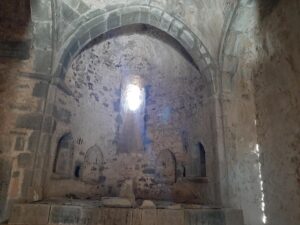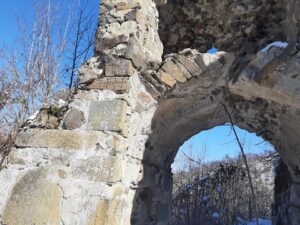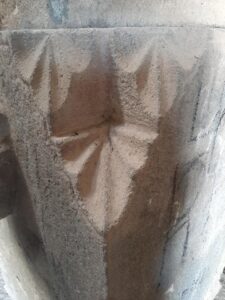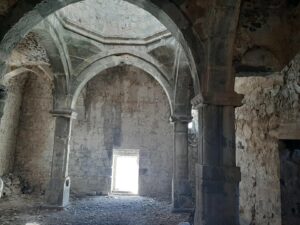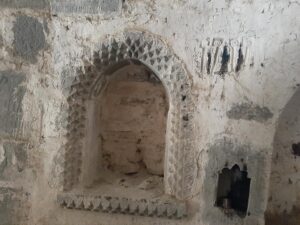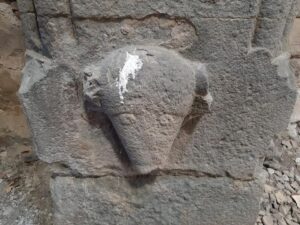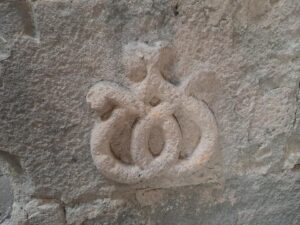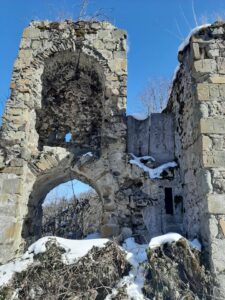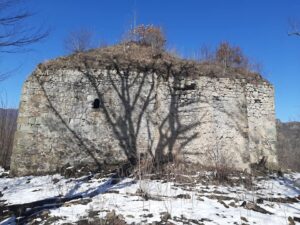The Khatravank monastery
Միջնադարյան Հայաստանի նշանավոր կրոնական ու մշակութային կենտրոններից Խաթրավանքը գտնվում է Արցախի Մարտակերտի շրջանի Վաղուհաս գյուղից արևմուտք, Թարթառ գետի աջ ափի մի դժվարամատչելի անտառապատ լեռնահարթակի վրա: Արձանագրություններում և պատմիչների մոտ վանքն անվանվում է Խադավանք կամ Խադարի վանք, որը ժողովրդական արտասանությամբ վերածվել է Խաթրավանքի: Խաթրավանքի անունը ծագել է Թադևոս առաքյալի Խադ աշակերտի անունից, որն եղել է Արցախում քրիստոնեություն քարոզող հայ առաջին հոգևորականներից մեկը։
Խաթրավանքը, հիմնադրված լինելով դեռ վաղ միջնադարում, 12-րդ դարում դարձավ Արցախի Ծարի իշխանության հոգևոր կենտրոնը և տապանատունը։ Վանքը տուժել է 1139 թ. երկրաշարժից և ավերվել 1143 թվականի սելջուկ-թուրքերի ասպատակություններից։ Խաթրավանքի վերաշինումը կապված է Հայաստանի 12-ից 13-րդ դարերի կրոնական խոշոր գործիչ Հովհաննես Խաչենեցու անվան հետ։ Նա եղել է ամիրսպասալար Սարգիս Զաքարյանի որդիների՝ Զաքարեի ու Իվանեի դաստիարակը։ 1204 թվին կառուցում է Խաթրավանքի Սուրբ Աստվածածին եկեղեցին, որն անփոփոխ հասել է մեզ։
Բացառիկ հետաքրքրություն է ներկայացնում Հովհաննես Խաչենացու շինարարական արձանագրությունը, որը սկսվում է հետևյալ խոսքերով. «Ի ՈԾՔ ԹՈՒԻՍ ԵՍ ՏՐ ՅՈՀԱՆԷՍ ՇԻՆԵՑԻ ԶԵԿԵՂԵՑԻՍ ԵՒ ԺՈՂՈՎԵՑԻ ԶԽԱՉ ԵՒ ԶԳԻՐՔ»: Պարզվում է, որ Հովհաննես Խաչենեցին, կառուցելով Խաթրավանքի եկեղեցին, այստեղ է հավաքում խաչքարեր ու ձեռագրեր, որի շնորհիվ վանքը դառնում է միջնադարյան Հայաստանի մի ուշագրավ գրադարան և քարեդարան-թանգարան: Խաթրավանքի մատենադարանը հետագայում հարստացել է ինչպես տեղի գրչատան ձեռագրերով, այնպես էլ դրսից ձեռք բերված գրքերով։
1226 թվականին իշխանուհի Դոփը կառուցում է եկեղեցուն հյուսիսից կից մատուռը և գավիթը: Վանքի շինությունները նորոգվել են 12-13 դարերի սահմանագլխին իշխան Գրիգոր Բ-ի և նրա կին Ասփայի կողմից, այնուհետև՝ 1691 թվին, Խաթրավանքի վարդապետների նախաձեռնությամբ:
Խաթրավանքի գմբեթն իր լուծումով եկեղեցիների համար եզակի է և փոխառված է հայկական ճարտարապետության ստեղծած գավիթների և ժամատների գմբեթների ձևից: Հայկական եկեղեցական ճարտարապետության համար գմբեթի այս անսովոր ձևի (առանց թմբուկի) Խաթրավանքում կիրառման ձևի գաղտնիքը բացատրվում է Հովհաննես վարդապետի կենսագրության մի կարևոր փաստով՝ նա մինչև Խաթրավանք տեղափոխվելը եղել է Սանահնի վանքի առաջնորդը և այնտեղ կառուցել է Ամենափրկիչ եկեղեցին և նրա գավիթը (1181 թ.): Հովհաննեսը Խաթրավանքի եկեղեցում կիրառել է ոչ միայն Սանահնի գավթի գմբեթի ձևը, այլև գավիթներին բնորոշ գմբեթակիր սյուներ, այն դեպքում, երբ հայ ճարտարապետության չորս հենակետերով բոլոր գմբեթավոր եկեղեցիներն ունեն մույթեր և ոչ թե սյուներ:
Հովհաննես վարդապետի շինարարական արձանագրության համաձայն, Խաթրավանքը 13-րդ դարի սկզբում վերաշինվել է որպես Խաչենի իշխանության մատենադարան և թանգարան: Այստեղ հավաքվել են Արցախի ձեռագրերը և միաժամանակ գրվել են նորերը։ Եկեղեցուց արևելք, լեռան լանջին, դեռ 19-րդ դարում եղել է մի մատուռ: Վանքի դիմաց, ներքևում, Թարթառ գետի վրա, Գրիգոր իշխանի կին Ասփան 14-րդ դարում կամուրջ է կառուցում դեպի Խաթրավանք տանող ճանապարհին և նրա մոտ խաչքար կանգնեցնում՝ կամրջի շինարարական արձանագրությամբ (կամուրջը նույնպես չի պահպանվել):
Աղբյուրը՝ Մուրադ Հասրաթյանի «Հայկական ճարտարապետության Արցախի դպրոցը» գրքից (Երևան, 1992թ.):





